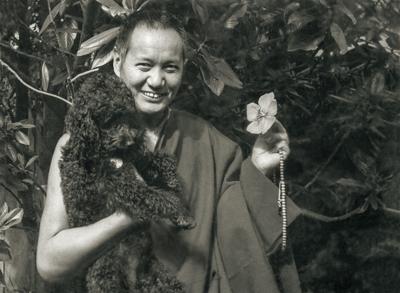Dear Friends,
Thank you for reading our monthly eletter. Please feel free to share it on social media or anywhere else. We would love more people to see it.
Our Big Love special offer ($35 instead of $85, subsidized by a kind benefactor) is still open. Nearly 150 out of 200 have sold already. So please don’t delay. And we are working on a new collection of Lama Yeshe’s discourses, which we will publish later in the year. Read on for more of what we’re up to here. Thank you so much.
From the Video Archive: Like a Star in the Daytime
This month from the LYWA video archive, Lama Zopa Rinpoche leads us in contemplation of the intimate appearances that trigger our delusions and helps us to distinguish between projections that are the source of all our suffering and the subtle dependent arising that exists like a star in the daytime. Rinpoche gave these teachings in Raleigh, North Carolina, in 2008.
Visit and subscribe to the LYWA YouTube channel to view more videos freely available from our archive. See also the FPMT YouTube channel for many more videos of Lama Zopa Rinpoche’s teachings.
On the LYWA Podcast: The Enemy is the Kindest Person
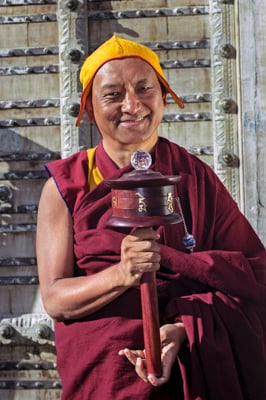 By developing the mind in patience, whatever happens to you, whatever harm others give you, you will never get angry.
By developing the mind in patience, whatever happens to you, whatever harm others give you, you will never get angry.
—Lama Zopa Rinpoche
This month on the LYWA podcast, Lama Zopa Rinpoche explains the power of the mind of patience to bring happiness to all beings we encounter on the path to enlightenment. The most powerful way for us to develop stable patience is to practice when confronted by the anger of others. Thus the angry person is the most kind of all, kinder than the friends that love us and the strangers we ignore. Rinpoche gave these teachings at the Thirty-third Kopan Meditation Course held at Kopan Monastery, Nepal, in 2000. Read along with the transcript here.
The LYWA podcast contains hundreds of hours of audio, each with links to the accompanying lightly edited transcripts. See the LYWA podcast page to search or browse the entire collection by topic or date, and for easy instructions on how to subscribe.
WHAT'S NEW ON OUR WEBSITE
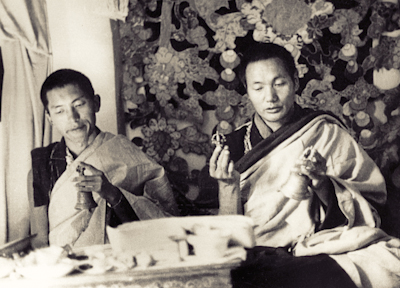 This month we have posted two teachings by Lama Zopa Rinpoche on the guru-disciple relationship. In The Kindness of the Guru, Rinpoche advises the importance of remembering the guru's good qualities and refers to the tireless work and inspiring example of his own guru, Lama Yeshe. This teaching was given to IMI Sangha at Tushita Meditation Centre, Dharamsala, during the First Enlightened Experience Celebration (EEC1) in May 1982. Also posted this month is Seeing the Guru as Buddha. In this short motivational teaching given at Tushita Meditation Centre in April 1987, Rinpoche explains why we need a guru and how to practice guru devotion correctly.
This month we have posted two teachings by Lama Zopa Rinpoche on the guru-disciple relationship. In The Kindness of the Guru, Rinpoche advises the importance of remembering the guru's good qualities and refers to the tireless work and inspiring example of his own guru, Lama Yeshe. This teaching was given to IMI Sangha at Tushita Meditation Centre, Dharamsala, during the First Enlightened Experience Celebration (EEC1) in May 1982. Also posted this month is Seeing the Guru as Buddha. In this short motivational teaching given at Tushita Meditation Centre in April 1987, Rinpoche explains why we need a guru and how to practice guru devotion correctly.
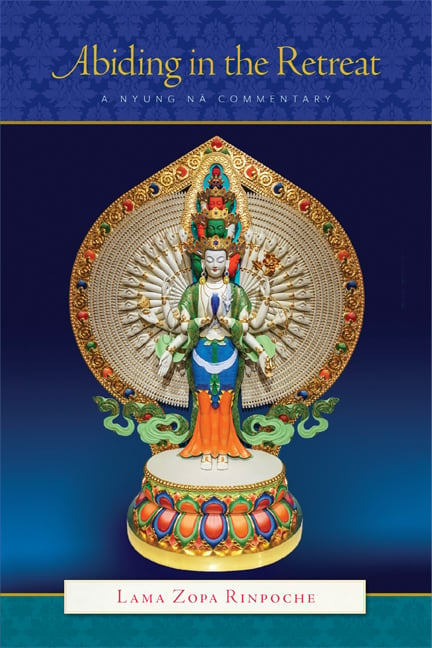 Also this month, we have posted several new chapters from Abiding in the Retreat. Abiding in the Retreat: A Nyung Nä Commentary combines several teachings given by Lama Zopa Rinpoche on nyung nä, a powerful two-day practice associated with Chenrezig, the Buddha of Compassion. Soon the entire book will be posted on our website to read. You can also freely download the book as a PDF file or order a free print copy here.
Also this month, we have posted several new chapters from Abiding in the Retreat. Abiding in the Retreat: A Nyung Nä Commentary combines several teachings given by Lama Zopa Rinpoche on nyung nä, a powerful two-day practice associated with Chenrezig, the Buddha of Compassion. Soon the entire book will be posted on our website to read. You can also freely download the book as a PDF file or order a free print copy here.
As our collection of audiobooks continues to grow, we are pleased to announce a new way of locating audiobooks in our store. Simply go to “Refine Search” on our shop webpage and tick the Audiobooks category. Our audiobook catalog includes free audiobooks from Google Play, as well as titles for purchase from Audible.
We also have new additions to Lama Zopa Rinpoche's Online Advice Book this month to share with you:
- A Real Spiritual Friend: Rinpoche sent this long letter with relationship advice to a student. Rinpoche said that the usual motivation for marriage is attachment and we need to have a bodhisattva attitude, free from the self-cherishing thought, so that our actions become the cause of enlightenment.
- Use the Complaints on the Path to Enlightenment:This advice was sent to a student who was being accused of different things and criticized publicly.
- Think How Kind They Are:Rinpoche gave this advice to a student who asked about stealing. The student had ordered an item online and did not get charged the full amount.
- The Merit Will Run Out: Rinpoche explained that a wealthy hotelier who appears happy and successful may be just collecting negative karma, while a simple monk who is practicing Dharma purely is creating the cause for happiness up to full enlightenment, even though they may be experiencing many problems in this life.
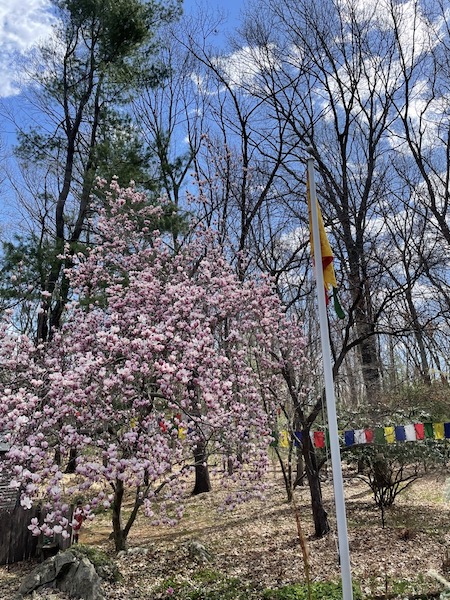 You can always find a list of all the newly posted advices from Lama Zopa Rinpoche on our website.
You can always find a list of all the newly posted advices from Lama Zopa Rinpoche on our website.
As always, thank you so much for your interest and support, which makes it all happen.
Spring has sprung at the home office and we’re feeling very optimistic about the year ahead. Here's a picture of the blooming magnolia tree in our yard.
Wherever you are in the world, we hope you are able to find some joy in the natural world around you too.
Big love,

Nick Ribush
Director
THIS MONTH'S TEACHING: What is Dharma?
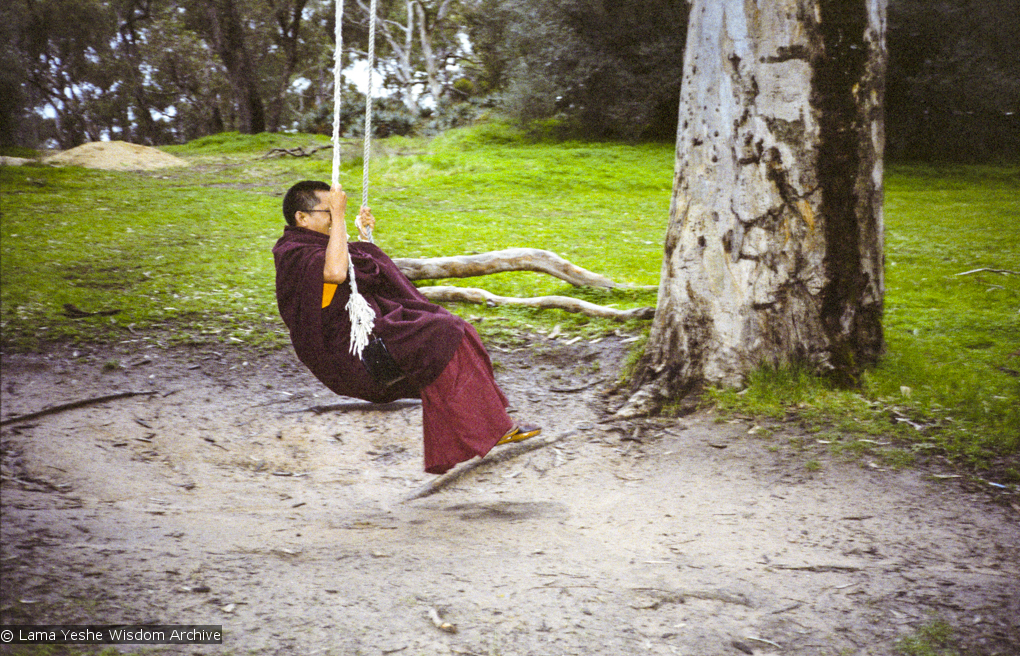 It is so important for us to understand what is Dharma and what is not Dharma. Dharma doesn’t mean only reciting prayers or meditating or reading texts or going around the temple. It doesn’t mean only that.
It is so important for us to understand what is Dharma and what is not Dharma. Dharma doesn’t mean only reciting prayers or meditating or reading texts or going around the temple. It doesn’t mean only that.
There is a story I want to tell you. In a place called Reting in Tibet, there’s a huge monastery where many Kadampa lamas came from. They were great meditators who achieved the path—bodhicitta and tantric realizations. The monastery was founded by Dromtönpa, who was the great translator for Lama Atisha, who came from Nalanda to restore Buddhadharma in Tibet, after which Buddhadharma was like the sun rising in Tibet.
There was one old man meditating and Gyalwa Dromtönpa, who was a layperson, was walking through the trees in the forest. He asked the old man, “What are you doing sir?” The man replied, “I’m meditating.” “It’s good that you are meditating, but it’s better if you practice Dharma,” said Dromtönpa.
So then the old man started to read scriptures. He thought maybe reading scriptures was Dharma. Again, one day, when Gyalwa Dromtönpa was walking around in the forest, he met the man and asked, “What are you doing, sir?” He said, “I’m reading texts.” Gyalwa Dromtönpa said, “That’s good that you are reading Dharma texts, but isn’t it better to practice Dharma?”
Then the old man thought maybe circumambulating the temple might be Dharma, so he spent time doing that. Again, one day Gyalwa Dromtönpa met the old man and asked, “What are you doing?” The man replied, “I’m circumambulating the temple.” “It’s good that you are circumambulating the temple but isn’t it better to practice Dharma?” said Dromtönpa.
Only the third time, after three answers, the old man asked, “What do you mean by practicing Dharma?” Then Gyalwa Dromtönpa replied, “Renounce this life. Renounce this life.” That doesn’t mean we give up our house, we give up food, we give up our clothing, and just live with a naked body in a cave or something. It doesn’t mean that. Probably, to renounce our body like that means to commit suicide. I’m joking. What it means is to give up the delusions from where all the suffering comes, from where the karma and all the suffering comes.
Among the delusions, there’s attachment, and from that, anger and other delusions can arise. Also, ignorance can arise. If we examine our life, it comes from attachment clinging to this life. We can see with a tree root, there are four or five big roots and from there, larger and larger, more and more, hundreds and thousands of additional roots come out. Like that, from attachment the problems of this life spread out. It’s unbelievable, unbelievable, the life problems, and from that we have so much suffering in the next life and the next life and all the coming lives. So much suffering.
From that karma we suffer for so many lifetimes and then we create suffering again, because of our habituation to creating negative karma before. Our suffering goes on and on without end. It is like that if we don’t know what is Dharma and what is not Dharma. All the problems in the world, what people suffer, everything, even the world wars, everything comes from attachment, worldly concern, desire, our own attachment. I heard—Roger was telling me—that the first world war started from one person.
To make it short, first understand right and wrong, and then karma. As I already started to speak about karma before, when I described the sentient beings and their suffering, one basic thing about karma is that all our happiness comes from virtuous karma. The result, happiness, comes. And all our suffering comes from nonvirtuous karma. If you have a lamrim text, with the examples of the ten nonvirtuous karmas and the ten virtuous karmas, that will give you some idea through the examples.
It is said by Buddha in tsom, which means a heap of teachings [Tib: Ched du brjod pa’i tshoms; Pali: Dhammapada]:
All phenomena are created by the mind.
The mind is the principal and it goes before.
This means [the mind precedes] the actions of body and speech. For example, by generating a good heart, which means thinking to not harm and to benefit others, then when we talk to someone we get happiness. To give you an example, it’s like the shadow which follows the body. Wherever the body goes, when there’s light, the shadow definitely follows. Whenever we have a good motivation, a good heart, then any actions of body, speech and mind that are done toward others, the resultant happiness always arises for us after that, and not only for ourselves but also for others, whether they are human beings or animals.
Excerpted from A Real Spiritual Friend, a long letter with relationship advice for a student given by Lama Zopa Rinpoche. You can find the complete advice here on our website.























